Red flowers are a type of flower that is characterized by their vibrant, striking red color. They are a popular choice for gardens, floral arrangements, and gifts because of their bold and eye-catching appearance.
There are many different types of red flowers, including roses, poppies, tulips, and carnations. Each type of red flower has its own unique characteristics and symbolism.
Red roses, for example, are often associated with love and passion. They are a popular choice for Valentine’s Day and other romantic occasions. Red poppies, on the other hand, are often associated with remembrance and are commonly used as a symbol for fallen soldiers.
In addition to their symbolism, red flowers are also prized for their beauty and versatility. They can be used to add color and texture to a garden, to create stunning floral arrangements, or to add a pop of color to a room.One of the most popular types of red flowers is the red tulip. These flowers are known for their bold, bright color and their graceful, elegant shape. They are often used in springtime floral arrangements and are a popular choice for weddings and other special occasions.
Another popular red flower is the red carnation. These flowers are often used in corsages and boutonnieres and are a popular choice for Mother’s Day and other special occasions. Overall, red flowers are a beloved and versatile type of flower that is admired for their striking beauty and rich symbolism. Whether you’re looking to add some color to your garden or to create a stunning floral arrangement, red flowers are a great choice.
Want to learn all flower’s name? this blog will help you to find all the flower’s names in English and all language as well.
Table of Contents
Toggle31 Red Flowers Name List
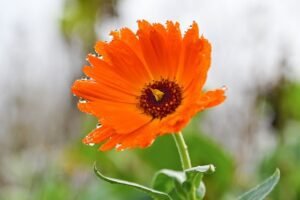
#1. Marigold
Marigold flowers are beautiful and easy to grow. They are popular annuals that come in a range of colors, including yellow, orange, and red.
- Scientific name: Tagetes erecta
- Plant type: Annual flowering plant
- Sunlight needs: Marigolds require full sun, which means they need at least six hours of direct sunlight per day. Make sure you plant them in a spot that receives plenty of sunlight.
- Plant size: Marigolds can grow to be one to four feet tall and one to two feet wide. They are relatively compact plants that don’t take up too much space in the garden.
- Growing zones: Marigolds can be grown in zones two to 11. They can be grown as perennials in zones nine to 11, but they are typically grown as annuals in most other zones.
- Soil needs: Marigolds prefer well-draining soil with a pH between 6.0 and 7.5. They can tolerate poor soil, but they prefer fertile soil with plenty of organic matter. Avoid heavy or clay soils, as they can lead to root rot.

#2.Chrysanthemum
Chrysanthemum flowers are popular perennials that come in a wide variety of colors, including pink, purple, white, and yellow. They are often used as fall decorations,
- Scientific name: Chrysanthemum spp.
- Plant type: Perennial flowering plant
- Sunlight needs: Chrysanthemums require full sun to partial shade, which means they need at least six hours of direct sunlight per day. However, in hotter climates, they may benefit from some afternoon shade.
- Plant size: Chrysanthemums can grow to be one to three feet tall and wide, depending on the variety. They are relatively compact plants that don’t take up too much space in the garden.
- Growing zones: Chrysanthemums can be grown in zones five to nine. They are hardy perennials that can survive winter temperatures as low as -20°F (-29°C).
- Soil needs: Chrysanthemums prefer well-draining soil that is rich in organic matter. They can tolerate a wide range of soil types, but they prefer slightly acidic soil with a pH between 6.0 and 6.5.

3. Amaryllis
Amaryllis flowers are beautiful, showy bulbs that come in a range of colors, including red, pink, and white. They are popular holiday decorations, but they can also bloom year-round with the right care.
- Scientific name: Hippeastrum spp.
- Plant type: Bulbous perennial flowering plant
- Sunlight needs: Amaryllis requires bright, indirect light, which means they need at least six hours of bright, filtered sunlight per day. They can also tolerate some direct sunlight in the morning or evening.
- Plant size: Amaryllis can grow to be one to two feet tall, depending on the variety. They are relatively compact plants that don’t take up too much space in the garden.
- Growing zones: Amaryllis can be grown indoors or outdoors in zones nine to 11. They are not frost-tolerant and should be grown as houseplants or dug up and stored indoors in colder climates.
- Soil needs: Amaryllis prefer well-draining soil that is rich in organic matter. They can tolerate a wide range of soil types, but they prefer slightly acidic soil with a pH between 6.0 and 6.5.

#4. Alstroemeria
Alstroemeria flowers are stunning, colorful blooms that are often used in floral arrangements. They are easy to grow and can bloom for weeks on end with the right care.
- Scientific name: Alstroemeria spp.
- Plant type: Herbaceous perennial flowering plant
- Sunlight needs: Alstroemerias require full sun to partial shade, which means they need at least six hours of direct sunlight per day. However, in hotter climates, they may benefit from some afternoon shade.
- Plant size: Alstroemerias can grow to be one to three feet tall and wide, depending on the variety. They are relatively compact plants that don’t take up too much space in the garden.
- Growing zones: Alstroemerias can be grown in zones six to 10. They are hardy perennials that can survive winter temperatures as low as -10°F (-23°C).
- Soil needs: Alstroemerias prefer well-draining soil that is rich in organic matter. They can tolerate a wide range of soil types, but they prefer slightly acidic soil with a pH between 6.0 and 6.5.
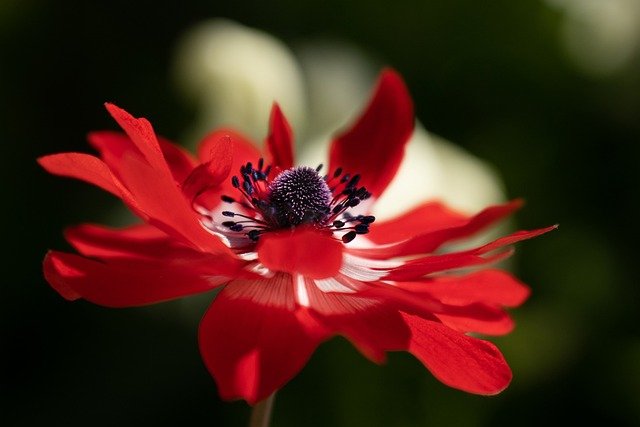
#5. Anemone
Anemone flowers are delicate, colorful blooms that are often seen in gardens and floral arrangements. They come in a variety of colors and can bloom in spring, summer, or fall,
- Scientific name: Anemone spp.
- Plant type: Herbaceous perennial flowering plant
- Sunlight needs: Anemones require full sun to partial shade, which means they need at least six hours of direct sunlight per day. However, in hotter climates, they may benefit from some afternoon shade.
- Plant size: Anemones can grow to be six to 12 inches tall and wide, depending on the variety. They are relatively compact plants that don’t take up too much space in the garden.
- Growing zones: Anemones can be grown in zones four to eight. They are hardy perennials that can survive winter temperatures as low as -30°F (-34°C).
- Soil needs: Anemones prefer well-draining soil that is rich in organic matter. They can tolerate a wide range of soil types, but they prefer slightly acidic soil with a pH between 6.0 and 7.0.

#6. Zinnia
Zinnia flowers are vibrant, colorful blooms that are easy to grow and come in a variety of shapes and sizes. They are often used in garden beds, borders, and containers.
- Scientific name: Zinnia elegans
- Plant type: Annual flowering plant
- Sunlight needs: Zinnias require full sun to thrive, which means they need at least six hours of direct sunlight per day.
- Plant size: Zinnias can grow to be one to three feet tall and wide, depending on the variety. They are relatively compact plants that don’t take up too much space in the garden.
- Growing zones: Zinnias can be grown in zones two to 11, depending on the variety. They are frost-sensitive and require warm temperatures to thrive.
- Soil needs: Zinnias prefer well-draining soil that is rich in organic matter. They can tolerate a wide range of soil types, but they prefer slightly acidic soil with a pH between 5.5 and 7.5.

#7. Poppy
Poppy flowers are beautiful, delicate blooms that come in a range of colors, including red, pink, orange, and white. They are a popular choice for gardens and floral arrangements.
- Scientific name: Papaver spp.
- Plant type: Herbaceous annual or perennial flowering plant
- Sunlight needs: Poppies require full sun to thrive, which means they need at least six hours of direct sunlight per day.
- Plant size: Poppies can grow to be one to three feet tall and wide, depending on the variety. They are relatively compact plants that don’t take up too much space in the garden.
- Growing zones: Poppies can be grown in zones two to nine, depending on the variety. They are hardy plants that can tolerate a range of temperatures.
- Soil needs: Poppies prefer well-draining soil that is rich in organic matter. They can tolerate a wide range of soil types, but they prefer slightly alkaline soil with a pH between 7.0 and 8.0.

#8. Rosa
also known as the rose, is one of the most beloved and popular flowers in the world. They are prized for their beauty, fragrance, and versatility in the garden. Here’s
- Scientific name: Rosa spp.
- Plant type: Woody perennial flowering plant
- Sunlight needs: Roses require full sun to thrive, which means they need at least six hours of direct sunlight per day. However, they can also tolerate some shade.
- Plant size: Roses can grow to be anywhere from one to eight feet tall and wide, depending on the variety. They are relatively large plants that can take up significant space in the garden.
- Growing zones: Roses can be grown in zones two to 11, depending on the variety. They are hardy plants that can tolerate a range of temperatures.
- Soil needs: Roses prefer well-draining soil that is rich in organic matter. They can tolerate a range of soil types, but they prefer slightly acidic soil with a pH between 6.0 and 6.5.

#9. Lilium
also known as the Lily, is a popular and beautiful flower that comes in a wide range of colors and sizes. They are prized for their showy blooms and sweet fragrance
- Scientific name: Lilium spp.
- Plant type: Herbaceous perennial flowering plant
- Sunlight needs: Lilies require full sun to partial shade to thrive. They need at least six hours of direct sunlight per day but can also grow well in partially shaded areas.
- Plant size: Lilies can grow to be anywhere from one to six feet tall and one to three feet wide, depending on the variety. They are relatively large plants that can take up significant space in the garden.
- Growing zones: Lilies can be grown in zones three to nine, depending on the variety. They are hardy plants that can tolerate a range of temperatures.
- Soil needs: Lilies prefer well-draining soil that is rich in organic matter. They can tolerate a range of soil types, but they prefer slightly acidic soil with a pH between 5.5 and 6.5.

#10.Calla Lily
also known as Zantedeschia aethiopica, is a beautiful and unique flower that is native to southern Africa. They are prized for their showy blooms and lush foliage. Here’s everything you need to know about growing and caring for Calla Lilies:
- Scientific name: Zantedeschia aethiopica
- Plant type: Herbaceous perennial flowering plant
- Sunlight needs: Calla Lilies require full to partial sunlight to thrive. They need at least six hours of direct sunlight per day but can also grow well in partially shaded areas.
- Plant size: Calla Lilies can grow to be anywhere from one to three feet tall and one to two feet wide, depending on the variety. They are relatively large plants that can take up significant space in the garden.
- Growing zones: Calla Lilies can be grown in zones eight to 11, depending on the variety. They are tender plants that prefer warm temperatures.
- Soil needs: Calla Lilies prefer well-draining soil that is rich in organic matter. They can tolerate a range of soil types, but they prefer slightly acidic soil with a pH between 6.0 and 6.5.

#11. Tulipa
also known as Tulipa, is a beautiful and iconic flower that is native to Eurasia. They are prized for their large, colorful blooms and are a popular choice for gardens and floral arrangements
- Scientific name: Tulipa
- Plant type: Herbaceous perennial flowering plant
- Sunlight needs: Tulips require full to partial sunlight to thrive. They need at least six hours of direct sunlight per day but can also grow well in partially shaded areas.
- Plant size: Tulips can grow to be anywhere from six inches to two feet tall, depending on the variety. They are relatively compact plants that can be grown in containers or in the garden.
- Growing zones: Tulips can be grown in zones three to eight, depending on the variety. They are cold-hardy plants that prefer cool temperatures.
- Soil needs: Tulips prefer well-draining soil that is rich in organic matter. They can tolerate a range of soil types, but they prefer slightly acidic soil with a pH between 6.0 and 7.0.
- Planting: Plant Tulip bulbs in the fall, six to eight weeks before the first hard frost in your area. Dig a hole that is two to three times deeper than the height of the bulb and plant the bulb with the pointed end facing up. Space the bulbs at least six inches apart.

#12. Dianthus caryophyllus
commonly known as the Carnation, is a beautiful and fragrant flowering plant that is native to the Mediterranean region. It is prized for its stunning blooms and long-lasting cut flowers
- Scientific name: Dianthus caryophyllus
- Plant type: Herbaceous perennial flowering plant
- Sunlight needs: Carnations require full sunlight to partial shade to thrive. They need at least six hours of direct sunlight per day, but can tolerate some shade in the afternoon.
- Plant size: Carnations can grow up to 24 inches tall and up to 12 inches wide, depending on the variety. They have a compact, bushy growth habit and are ideal for borders and containers.
- Growing zones: Carnations can be grown in zones six to nine, depending on the variety. They prefer cool temperatures and can tolerate light frost.
- Soil needs: Carnations prefer well-draining soil that is rich in organic matter. They can tolerate a range of soil types, but prefer slightly alkaline soil with a pH between 6.0 and 7.0.
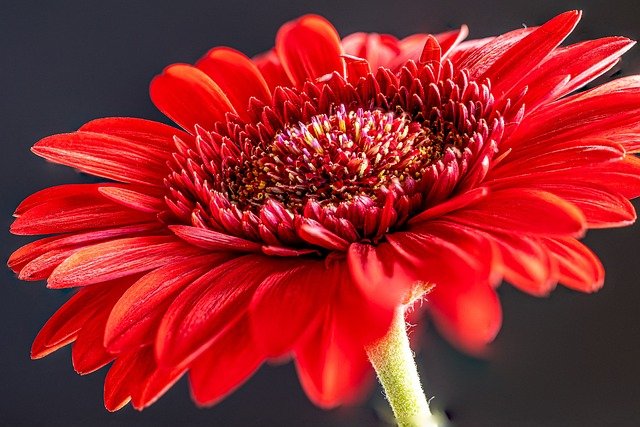
#13. Gerbera Daisy
The Gerbera Daisy is a popular flowering plant that is prized for its vibrant, colorful blooms. It is native to South Africa and belongs to the Asteraceae family. Here’s
- Scientific name: Gerbera jamesonii
- Plant type: Herbaceous perennial flowering plant
- Sunlight needs: Gerbera Daisies require full sunlight to thrive, but can tolerate partial shade in hot climates. They need at least six hours of direct sunlight per day.
- Plant size: Gerbera Daisies can grow up to 18 inches tall and up to 12 inches wide, depending on the variety. They have a compact growth habit and are ideal for borders, containers, and cut flowers.
- Growing zones: Gerbera Daisies can be grown in zones 9 to 11, depending on the variety. They prefer warm temperatures and cannot tolerate frost.
- Soil needs: Gerbera Daisies prefer well-draining soil that is rich in organic matter. They can tolerate a range of soil types, but prefer slightly acidic soil with a pH between 5.5 and 6.5.

#14. Cockscomb
The Cockscomb Flower is a unique and eye-catching flowering plant that is popular for its showy, brightly colored blooms that resemble the head of a rooster. It belongs to the Amaranthaceae family and is native to Africa
- Scientific name: Celosia cristata
- Plant type: Annual flowering plant
- Sunlight needs: Cockscomb Flowers require full sunlight to thrive, but can tolerate partial shade in hot climates. They need at least six hours of direct sunlight per day.
- Plant size: Cockscomb Flowers can grow up to 2 to 3 feet tall and up to 1 to 2 feet wide, depending on the variety. They have a compact growth habit and are ideal for borders, containers, and cut flowers.
- Growing zones: Cockscomb Flowers can be grown in zones 2 to 11, depending on the variety. They prefer warm temperatures and cannot tolerate frost.
- Soil needs: Cockscomb Flowers prefer well-draining soil that is rich in organic matter. They can tolerate a range of soil types, but prefer slightly acidic soil with a pH between 6.0 and 7.0.

#15. Peony
The Peony Flower is a popular and beloved flowering plant that is known for its large, colorful blooms and sweet fragrance. It belongs to the Paeoniaceae family and is native to Asia, Europe,
- Scientific name: Paeonia spp.
- Plant type: Perennial flowering plant
- Sunlight needs: Peony Flowers require full sunlight to thrive, but can tolerate some partial shade. They need at least six hours of direct sunlight per day.
- Plant size: Peony Flowers can grow up to 3 to 4 feet tall and up to 2 to 3 feet wide, depending on the variety. They have a bushy growth habit and are ideal for borders, hedges, and cut flowers.
- Growing zones: Peony Flowers can be grown in zones 3 to 8, depending on the variety. They prefer cold winters and mild summers.
- Soil needs: Peony Flowers prefer well-draining soil that is rich in organic matter. They can tolerate a range of soil types, but prefer slightly acidic soil with a pH between 6.0 and 7.0.

#16. Dianthus
also known as Carnations or Pinks, is a popular garden plant known for its sweet fragrance and colorful blooms. It belongs to the Caryophyllaceae family and is native to Europe and Asia
- Scientific name: Dianthus spp.
- Plant type: Perennial flowering plant
- Sunlight needs: Dianthus Flowers require full sunlight to thrive, but can tolerate some partial shade. They need at least 6 hours of direct sunlight per day.
- Plant size: Dianthus Flowers can grow up to 6 to 12 inches tall and up to 8 to 12 inches wide, depending on the variety. They have a mounding growth habit and are ideal for borders, rock gardens, and containers.
- Growing zones: Dianthus Flowers can be grown in zones 3 to 9, depending on the variety. They prefer cool temperatures and can tolerate some frost.
- Soil needs: Dianthus Flowers prefer well-draining soil that is slightly alkaline to neutral with a pH between 6.0 and 7.5. They can tolerate a range of soil types, but prefer sandy or loamy soil.

#17. Begonia
Begonia is a genus of flowering plants with over 1,800 species. They are popular for their colorful and long-lasting blooms, making them a favorite among gardeners and plant enthusiasts.
- Scientific Name: Begonia spp.
- Plant Type: Perennial or annual flowering plant
- Sunlight Needs:
- Begonias prefer partial to full shade, making them ideal for growing in areas with filtered sunlight or morning sun and afternoon shade.
- They can tolerate some direct sunlight, but too much exposure to the sun can scorch their leaves and blooms.
- Plant Size:
- The size of Begonia plants varies depending on the species and cultivar.
- Generally, they range from 6 inches to 3 feet in height and spread.
- Growing Zones:
- Begonias can grow in a wide range of zones, from tropical to temperate regions.
- They are commonly grown as houseplants in colder regions and as outdoor plants in warmer zones.
- Soil Needs:
- Begonias prefer well-draining soil that is rich in organic matter.
- They thrive in a slightly acidic soil with a pH between 5.5 and 6.5.
- The soil should be moist but not waterlogged, as Begonias are susceptible to root rot.

#18. Dahlia
Dahlias are popular ornamental plants that come in a wide range of colors, shapes, and sizes. Here is an article with their scientific name, plant type, sunlight needs, plant size,
- Scientific name: Dahlia
- Plant type: Herbaceous perennial
- Sunlight needs: Full sun to partial shade (at least 6 hours of sunlight per day)
- Plant size: Depending on the variety, dahlias can grow from 1 to 6 feet tall and up to 4 feet wide
- Growing zones: Dahlias are winter-hardy in zones 8-11, but can be grown as annuals in cooler climates
- Soil needs:
- Well-drained soil that is rich in organic matter
- Soil pH between 6.0 and 7.5
- Soil should be kept consistently moist but not waterlogged

#19. Pentas
Pentas is a beautiful flowering plant that is native to Africa. Here is an article with their scientific name, plant type, sunlight needs, plant size, growing zones, and soil needs in bullet point
- Scientific name: Pentas lanceolata
- Plant type: Perennial
- Sunlight needs: Full sun to partial shade (at least 6 hours of sunlight per day)
- Plant size: Pentas can grow up to 3 feet tall and up to 2 feet wide, depending on the variety
- Growing zones: Pentas is typically grown as an annual in most regions, but is winter-hardy in zones 10-11
- Soil needs:
- Well-drained soil that is rich in organic matter
- Soil pH between 5.5 and 7.5
- Soil should be kept consistently moist but not waterlogged

#20. Red Sunflower
Red sunflowers are a stunning variety of sunflowers that produce striking, deep red blooms. Here is an article with their scientific name, plant type, sunlight needs, plant size, growing zones,
- Scientific name: Helianthus annuus
- Plant type: Annual
- Sunlight needs: Full sun (at least 6 hours of sunlight per day)
- Plant size: Red sunflowers can grow up to 6 feet tall and up to 2 feet wide
- Growing zones: Red sunflowers can be grown in zones 1-10, depending on the variety and climate conditions
- Soil needs:
- Well-drained soil that is rich in organic matter
- Soil pH between 6.0 and 7.5
- Soil should be kept consistently moist but not waterlogged
- Propagation: Red sunflowers can be propagated by seeds. They can be started indoors 4-6 weeks before the last frost or sown directly into the garden after the danger of frost has passed. Sow seeds 1 inch deep and 6 inches apart, and thin to a final spacing of 1-2 feet apart

#21. Hibiscus
Hibiscus is a beautiful flowering plant that is known for its showy, colorful blooms. Here are some details about the plant:
- Scientific name: Hibiscus rosa-sinensis
- Plant type: Perennial shrub
- Sunlight needs: Full sun to partial shade
- Plant size: Can grow up to 10 feet tall and 6 feet wide, depending on the variety
- Growing zones: 9 to 11
- Soil needs: Well-drained soil that is rich in organic matter, with a pH between 6.0 and 7.0

#22. Azalea
Azalea is a popular flowering shrub known for its showy blooms and attractive foliage. Here is some information about the Azalea flower:
- Scientific Name:
- Azalea is the common name for plants belonging to the Rhododendron genus.
- The scientific name for Azalea is Rhododendron subgenus Pentanthera.
- Plant Type:
- Azalea is a flowering shrub that typically grows 2-8 feet tall and 3-6 feet wide.
- It is a broadleaf evergreen, meaning that it keeps its leaves year-round.
- Too much sun can cause the leaves to wilt or scorch, while too little sun can result in poor flowering.
- Plant Size:
- Growing Zones:
- Azalea grows best in USDA zones 5-9.
- Some varieties are more cold-hardy and can grow in zone 4, while others are better suited for warmer climates in zones 9-10.
- Soil Needs:
- Azalea prefers acidic, well-draining soil with a pH between 4.5 and 6.0.
- It also prefers soil that is rich in organic matter and evenly moist, but not waterlogged.
- Amending the soil with peat moss or compost can help improve drainage and fertility.

#23. Sweet pea
Sweet pea flowers are an annual plant known for their fragrant and colorful blooms. Below are some key details about sweet pea flowers:
- Scientific Name:
- Lathyrus odoratus
- Plant Type:
- Annual climbing plant
- Sunlight Needs:
- Full sun to partial shade
- Plant Size:
- Can grow up to 6 feet (1.8 meters) in height
- Typically grows as a vine or climbing plant
- Can also be grown in pots or containers
- Growing Zones:
- Sweet peas grow well in cool climates
- Best suited for USDA hardiness zones 2-11
- Soil Needs:
- Well-draining soil is important for sweet pea flowers
- Soil should be fertile and moist, but not waterlogged
- Soil pH should be slightly acidic to neutral (around 6.0-7.0)

#24. Cosmos
Catmint is known for its aromatic, gray-green foliage and showy spikes of lavender-blue flowers. The flowers are attractive to bees, butterflies, and hummingbirds. Catmint is often used in borders, rock gardens,
- Scientific Name: Nepeta spp.
- Plant Type: Catmint is a herbaceous perennial that is grown for its attractive foliage and showy, aromatic flowers.
- Sunlight Needs: Catmint prefers full sun, but can tolerate some light shade.
- Plant Size: Catmint can grow to be 1-3 feet (0.3-0.9 m) tall and wide, depending on the variety.
- Growing Zones: Catmint is hardy in USDA growing zones 3-8, depending on the variety. It is native to Europe and Asia.
- Soil Needs: Catmint prefers well-draining soil that is moderately fertile. It can tolerate a range of soil types, but does best in soil that is neutral to slightly alkaline (pH 6.0-7.5).

#25. Hyacinth
Hyacinths bloom in spring, usually from mid-March to mid-May, depending on the climate and the variety.
- Scientific name: Hyacinthus orientalis
- Plant type: Perennial bulbous plant
- Sunlight needs: Full sun to partial shade
- Plant size: Height of 6-12 inches (15-30 cm) and width of 3-6 inches (8-15 cm)
- Growing zones: USDA hardiness zones 4-8
- Soil needs: Well-drained soil with medium moisture and rich in organic matter

#26. Canna
Purple Pansies are part of the viola family and are known for their attractive, heart-shaped flowers. The flowers come in a range of colors including purple, yellow, white, blue, and red. Purple Pansies are often used in borders,
- Scientific Name: Viola tricolor hortensis
- Plant Type: The Purple Pansy is a herbaceous biennial or annual flowering plant that is grown for its colorful flowers.
- Sunlight Needs: Purple Pansies prefer full sun to partial shade.
- Plant Size: Purple Pansies can grow up to 6-9 inches (15-23 cm) tall and can spread up to 9-12 inches (23-30 cm) wide.
- Growing Zones: Purple Pansies are hardy in USDA growing zones 4-8.
- Soil Needs: Purple Pansies prefer well-drained soil that is moist and fertile. The soil pH should be neutral to slightly alkaline (pH 6.0-7.5).

#27. Clematis
Clematis is a genus of flowering vines and herbaceous perennials that are known for their showy, colorful flowers. There are over 300 species of Clematis, ranging in color from white to pink to purple
- Scientific name:
- The scientific name for the Clematis Flower is Clematis.
- Plant type:
- Clematis is a climbing plant that can grow as a vine or a shrub, depending on the variety.
- Sunlight needs:
- Clematis prefers full sunlight to partial shade, although some varieties can tolerate full shade.
- Plant size:
- The size of the plant can vary depending on the variety, with some reaching heights of up to 20 feet.
- Growing zones:
- Clematis can grow in a variety of climates, but they are best suited for USDA Hardiness Zones 3-9.
- Soil needs:
- Clematis prefers well-draining soil that is rich in organic matter, with a pH between 6.0 and 7.0.
- They also prefer soil that is consistently moist, but not waterlogged.

#28. Bee Orchid
Flower
Bee Orchid is named for its flowers, which resemble a female bee and attract male bees for pollination. The flowers are generally pinkish-purple with a large,
- Scientific Name: Ophrys apifera
- Plant Type: Perennial orchid
- Sunlight Needs: Full sun to partial shade
- Plant Size: Typically grows 20-50 cm tall
- Growing Zones: Hardy in USDA zones 4-9
- Soil Needs: Well-draining soil, preferably with low fertility
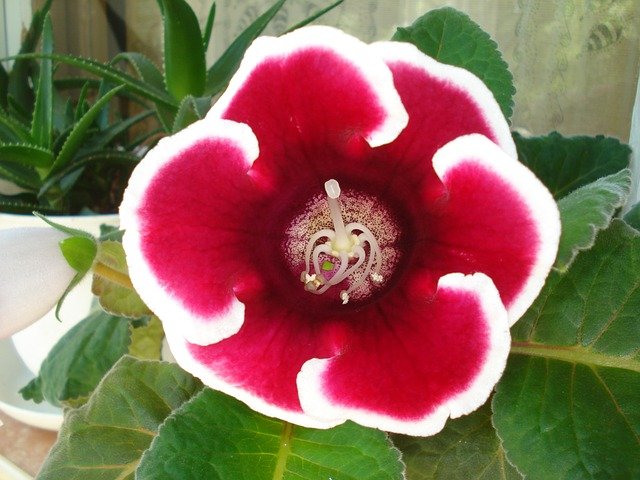
#29. Gloxinia
Gloxinia is a genus of flowering plants in the family Gesneriaceae. These plants are native to tropical regions of South America and are known for their large, showy flowers.
- Scientific name:
- The scientific name for Gloxinia is Sinningia speciosa.
- Plant type:
- Gloxinia is a herbaceous perennial plant that can grow up to 30 cm in height.
- It has a rosette of leaves at the base and produces trumpet-shaped flowers on upright stems.
- Sunlight needs:
- Gloxinia prefers bright, indirect sunlight.
- Too much direct sunlight can scorch its leaves, while too little light can result in weak growth and few flowers.
- Plant size:
- Gloxinia typically grows to be around 20-30 cm tall and 20 cm wide.
- Growing zones:
- Gloxinia is typically grown indoors or in greenhouses.
- It is not frost hardy and prefers temperatures between 18-21°C.
- Soil needs:
- Gloxinia prefers well-draining, moist soil that is rich in organic matter

#30. Hellebores
Hellebores are also commonly known as Lenten rose, Christmas rose, or Winter rose.Hellebores are deer-resistant and can be used in woodland gardens, shade gardens, and as border plantsScientific name: Plant type: Perennial flowering plant
- Sunlight needs: Hellebores prefer partial to full shade, but can tolerate some morning sun.
- Plant size: Hellebores can grow up to 18-24 inches tall and wide, depending on the variety.
- Growing zones: Hellebores are cold-hardy plants and can grow in zones 4-9.
- Soil needs: Hellebores prefer well-draining soil that is rich in organic matter. They also prefer a soil pH that is neutral to slightly alkaline.
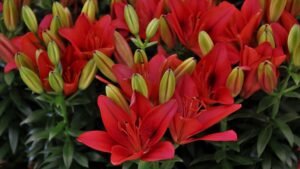
#31. Daylily
Daylilies are known for their beautiful and colorful blooms, which come in a variety of shapes, sizes, and colors. They are a popular choice for gardeners due to their hardiness, adaptability,
- Scientific name: Hemerocallis
- Plant type: Herbaceous perennial
- Sunlight needs: Full sun to partial shade
- Plant size: 1 to 4 feet tall, 1 to 3 feet wide
- Growing zones: USDA zones 3-9
- Soil needs: Well-draining soil, rich in organic matter

